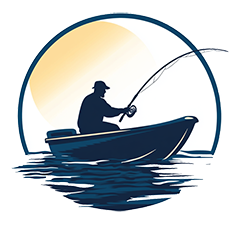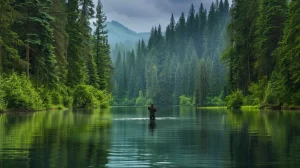Wilderness angling strategies demand a blend of expertise and adaptability to secure a successful catch in untamed habitats. With a myriad of techniques at an angler’s disposal, the key lies in astute gear selection, precise location scouting, and mastering water reading skills. As the elements often dictate the outcome, a nuanced understanding of weather patterns and terrain adaptation is paramount for a fruitful angling expedition. In the wilderness, every cast holds the promise of a connection with nature’s bounty, making the pursuit of wilderness angling strategies a captivating endeavor for those seeking to unlock the secrets of the wild.
Table of Contents
Gear Selection
When preparing for wilderness angling, the critical first step is meticulous gear selection tailored to the target fish species and fishing environment. One of the most crucial gear components to consider is the fishing line. The fishing line is the crucial link between the angler and the fish, making it essential to choose the right type for the specific conditions. Factors such as line weight, material, and visibility play a significant role in determining the line’s effectiveness. For instance, lighter lines are more suitable for clear water where fish may be easily spooked, while heavier lines are ideal for rougher terrains or larger, more aggressive fish species.
Choosing the appropriate fishing line can enhance casting distance, control, and sensitivity, ultimately improving the overall angling experience. It is essential to research reputable brands and read reviews to make informed decisions when selecting a fishing line that aligns with the target fish species and the wilderness environment.
Location Scouting
When scouting for fishing locations, understanding the terrain and exploring sources of water are crucial aspects to consider. Terrain assessment tips can help anglers identify suitable habitats for various fish species. Exploring the water sources in an area can provide insight into factors like temperature, depth, and vegetation that influence fishing success.
Terrain Assessment Tips
In wilderness angling, an essential aspect of successful fishing lies in effectively assessing the terrain to pinpoint optimal locations for catching fish. To find fish, look for areas with structure such as rocks, fallen trees, and vegetation, as these provide potential hiding spots. Focus on spots where different water currents converge, as they attract fish seeking food. Check the water depth, as various fish species prefer different depths for feeding and hiding. Observing insects, birds, or other wildlife near the water can indicate fish activity. Additionally, take note of underwater vegetation or algae beds, as they serve as feeding grounds for fish. By paying attention to these terrain assessment tips, anglers can increase their chances of a successful wilderness angling experience.
Water Source Exploration
Exploring water sources in the wilderness entails scouting for areas displaying visible signs of fish activity, such as jumping or feeding, to identify prime fishing locations. When seeking out the best spots for angling, pay close attention to water clarity. Clear water not only indicates a healthier ecosystem but also allows for better visibility, increasing your chances of spotting fish. Additionally, consider the water temperature and flow rate as they can influence fish behavior and feeding patterns. Look for areas with underwater structures like rocks, logs, or vegetation, as these provide shelter and food sources for fish. Utilizing local knowledge or maps can further guide you to specific fishing hotspots within the wilderness area, enhancing your angling experience.
Wilderness Angling Strategies Terrain Adaptation
Understanding the natural advantages of different habitats and selecting the right water bodies are essential aspects of terrain adaptation in wilderness angling. By recognizing the influence of factors like vegetation, water depth, and underwater structures, anglers can strategically position themselves for successful catches. Adapting to various terrains, from rivers to coastal areas, requires anglers to consider weather conditions and seasonal changes to effectively target different fish species.
Natural Habitat Advantages
Natural habitats provide anglers with a rich array of fishing opportunities tailored to specific terrain types, enabling them to strategically adapt their techniques and gear for optimal success. Fishing techniques play a crucial role in maximizing the advantages offered by different habitats. Anglers need to tailor their approach based on the habitat’s characteristics, such as using topwater lures for shallow flats or deep diving lures for rocky bottoms. Understanding the behavior of fish in their natural habitats allows anglers to choose the right baits and methods to increase their chances of a successful catch. By studying the ecosystem and adapting their gear accordingly, anglers can immerse themselves in the freedom of wilderness angling while maximizing their fishing experience.
Water Body Selection
When selecting a water body for angling purposes, it is essential to consider factors such as depth, clarity, natural cover, structure, currents, depths, temperature, and oxygen levels to optimize visibility and attract fish effectively. Fishing in wilderness areas offers the freedom to choose from a variety of water bodies, each with its unique characteristics that can either enhance or challenge your angling experience. Opt for water bodies with clear depths that allow you to spot fish easily and natural covers like vegetation or rocks that serve as attractive spots for fish to gather. Additionally, seek out areas with diverse structures such as fallen trees or underwater ledges where fish can hide, and varying currents and depths to target a wide range of fish species. Evaluating the temperature and oxygen levels of the water body can also help determine the activity levels of fish, aiding in a successful fishing expedition.
Water Reading Skills
Observing surface patterns, currents, and structures is essential for developing effective water reading skills in wilderness angling. To locate fish habitats, look for areas with eddies, riffles, and calm pockets as potential fish-holding spots. Understanding water temperature, oxygen levels, and food sources can aid in identifying prime fishing locations. Pay attention to underwater vegetation, rocks, and structures that provide cover and shelter for fish. By honing these water reading skills, anglers can significantly improve their chances of successful fishing in various water bodies. The ability to interpret the water’s movements and features allows anglers to anticipate where fish may be hiding or feeding. Developing these skills not only enhances the angling experience but also increases the likelihood of a rewarding catch. Next, we will delve into ‘Weather Awareness’ to further equip anglers with the knowledge needed to thrive in the wilderness.
Weather Awareness
Enhancing awareness of weather dynamics is crucial for anglers seeking to optimize their fishing strategy in the wilderness. Understanding how weather patterns influence flora and fauna can significantly improve angling success. Changes in barometric pressure, for instance, can impact fish behavior, with low pressure often signaling increased activity among fish, making it an ideal time for angling. Additionally, wind direction plays a vital role in determining where fish congregate, as they tend to gather in areas where food is carried by the wind. Monitoring wind patterns can help anglers position themselves strategically for better catches. Cloud cover is another weather factor that affects angling, as it influences fish visibility and feeding habits. Overcast skies often lead to more active fish, presenting anglers with prime opportunities to reel in their catch. By staying informed about weather forecasts and being prepared for sudden changes, anglers can enhance their understanding of how weather impacts flora and fauna, ultimately improving their wilderness angling experience.
Stealth and Patience
Maintaining a high level of stealth and patience is paramount for anglers engaged in wilderness fishing expeditions, ensuring minimal disturbance and optimal observation of fish behavior. In the tranquil wilderness setting, where the slightest noise can send fish darting away, mastering the art of moving quietly and slowly is crucial. By embodying stealth, anglers can prevent disturbances in the water, increasing their chances of a successful catch. Patience plays an equally vital role, allowing anglers to carefully observe fish behavior, waiting for the opportune moment to make their move.
Furthermore, understanding the environment and paying attention to natural cues can provide valuable insights into fish movements and behaviors. By honing the skills of stealth and patience, anglers can significantly enhance the success and fulfillment of their fishing experiences in the wild. Embracing these principles not only leads to more fruitful catches but also fosters a deep connection with nature, making each expedition a rewarding adventure of freedom and discovery.
Bait and Lure Choices
To optimize success in wilderness angling expeditions, strategic selection of bait and lures is essential for enticing a variety of fish species. Natural baits like worms, insects, and fish eggs are effective in attracting a wide range of fish species in the wild. Understanding the feeding habits of local fish species is crucial for choosing the right bait or lure. Artificial lures such as spinners, spoons, and plugs can mimic the movement of prey, appealing to predatory fish. Live bait options like minnows or crayfish are particularly enticing to larger fish, offering a substantial meal for potential catches.
Experimentation with different bait and lure combinations, tailored to the time of day and water conditions, can significantly enhance the chances of a successful fishing excursion in the wilderness. By adapting bait and lure choices to the specific species of fish present in the area, anglers can increase their opportunities for a rewarding and fulfilling angling experience in the great outdoors.
Casting Techniques
Mastering effective casting techniques is essential for anglers seeking to improve their precision and distance when fishing in wilderness environments. Proper casting technique involves holding the fishing rod with a firm grip and utilizing your wrist to flick the rod forward. It is crucial to release the line smoothly and at the right angle to achieve the desired distance and accuracy in casting. One beneficial method to enhance your casting skills is the ‘pendulum cast,’ which leverages your body’s motion to generate more power and distance. For precision casting, mastering the ‘overhead cast’ is key; this technique involves smoothly accelerating the rod tip and releasing the line at the optimal moment. Additionally, the ‘sidearm cast’ technique is ideal for low-profile casting in situations with obstacles or when a stealthy approach is necessary. By practicing and honing these casting techniques, anglers can elevate their wilderness angling experience to new heights.
Safety Precautions
Ensuring wilderness angling safety requires careful consideration of essential precautions to mitigate potential risks and ensure a successful and secure fishing experience. Safety precautions are crucial when venturing into the wilderness for angling. Always wear a life jacket to prevent accidents, especially when fishing in remote areas. Informing someone of your fishing location and expected return time enhances safety by enabling timely assistance in case of emergencies. Stay vigilant of weather conditions and signs of changing weather patterns to avoid getting caught in dangerous situations. Carrying a well-equipped first aid kit is essential for addressing any medical emergencies that may arise during your fishing expedition. Additionally, staying hydrated and protecting yourself from sun exposure with sunscreen and a hat are vital for your well-being during wilderness angling trips. By following these safety precautions, anglers can enjoy their wilderness fishing adventures with peace of mind and freedom.

